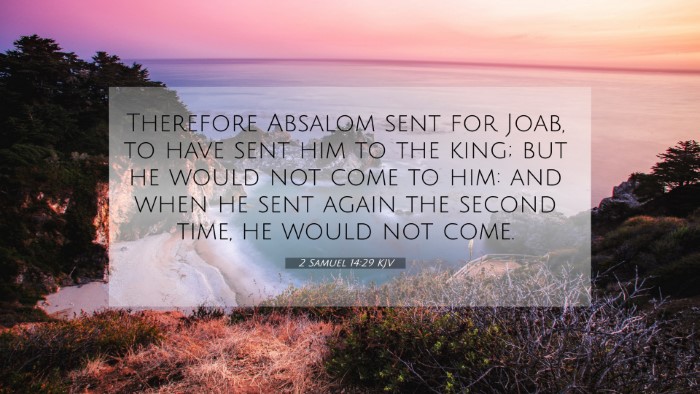Understanding 2 Samuel 14:29
Bible Verse: “And Absalom sent for Joab, to have him sent to the king; but he would not come to him: and when he sent again the second time, he would not come.” (2 Samuel 14:29 KJV)
Context of 2 Samuel 14:29
In this verse, we find Absalom, the son of King David, seeking to reconcile with his father. Absalom's actions depict a tense relationship that reflects deeper themes of familial strife, rebellion, and the quest for acceptance.
Meaning and Interpretation
This verse serves to illustrate Absalom's desperation to connect with Joab, the commander of David's army, and, through him, gain an audience with King David. When Joab refuses to respond to Absalom's summons, it indicates the tension and estrangement growing within the royal family.
Insights from Commentaries
- Matthew Henry: This commentary emphasizes the significance of Absalom's actions, highlighting his impatience and willingness to take matters into his own hands when faced with rejection. He suggests that Absalom’s methodology reflects a broader theme of rebellion against divine order and authority.
- Albert Barnes: Barnes focuses on the implications of Absalom's attempts to communicate with Joab. He underlines that Absalom’s failure to reach Joab represents the estrangement not only from Joab but from the king himself. This illustrates the consequences of Absalom’s earlier actions and decisions.
- Adam Clarke: Clarke provides psychological insights into Absalom’s character, interpreting his behavior as driven by a deep-seated need for acceptance and recognition. He posits that Absalom’s actions foreshadow his later, perilous choices.
Cross-Referencing Biblical Texts
This verse demonstrates a rich tapestry of interconnections throughout the Bible, reflecting themes of conflict, reconciliation, and divine justice. Below are essential cross-references:
- 2 Samuel 13:39 - This earlier verse sets the stage for the familial conflict, showcasing Absalom's growing discontent and desire for revenge against Amnon.
- 2 Samuel 15:1-6 - This passage depicts Absalom’s further rebellion and the deceit he employs to turn the hearts of Israel against his father, King David.
- Proverbs 16:18 - “Pride goes before destruction, and a haughty spirit before a fall,” paralleling Absalom's pride in seeking power.
- Psalm 51:12 - Reflects David’s plea for restoration after sin, which echoes Absalom's yearning for reconciliation with his father.
- Matthew 5:23-24 - Jesus’ teaching on the importance of reconciliation resonates with Absalom’s desire to restore his relationship with David.
- 1 Peter 5:5 - Insights on humility and rebellion illustrate the spiritual undercurrents behind Absalom’s actions.
- Luke 15:11-32 - The Parable of the Prodigal Son serves as a thematic parallel, displaying themes of estrangement and return within a family context.
Thematic Connections
The themes found in 2 Samuel 14:29 can be further understood through broader Bible narratives:
- Family Dynamics: Throughout scripture, the complexity of familial relationships is explored, revealing the destructive nature of pride and rebellion.
- Desire for Leadership: Characters like Absalom reflect the human inclination towards authority and recognition, often leading to conflict.
- Reconciliation: The overarching theme of reconciliation is critical, as showcased in both the Old and New Testaments, maintaining God’s desire for restored relationships.
Practical Applications
In contemplating the lessons from this verse, one may consider:
- The need for humility: Acknowledging one's position in familial and social structures can lead to healthier relationships.
- Seeking reconciliation: Taking initiative to mend relationships rather than resorting to pride or rebellion can transform conflicts into opportunities for growth.
- The importance of communication: Like Absalom, open and honest communication with those we are estranged from is vital for healing.
Conclusion
2 Samuel 14:29 encapsulates pivotal themes of estrangement and the longing for reconciliation within the biblical narrative. Through careful cross-referencing and thematic exploration, we recognize the complexities of the human experience as depicted in Scripture.
For those studying this verse, utilizing tools for Bible cross-referencing can significantly enhance understanding and provide rich insights into how Scriptures relate to one another. A comprehensive Bible concordance and consistent use of cross-reference Bible study methods can facilitate deeper theological reflection.
Whether exploring the connections between Old and New Testament teachings or engaging in comparative studies of biblical narratives, the insights derived from 2 Samuel 14:29 remind us of the enduring truths about family, authority, and the divine call to reconciliation.





